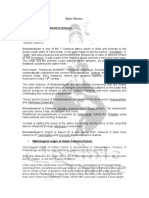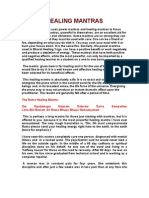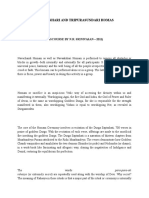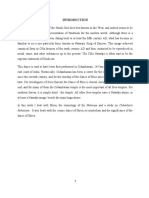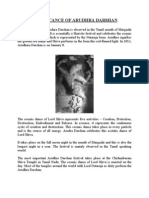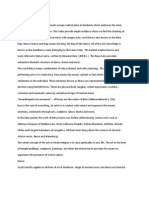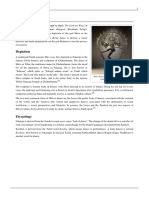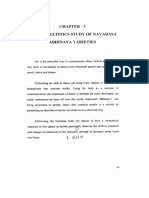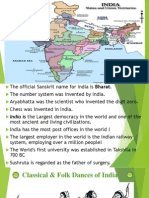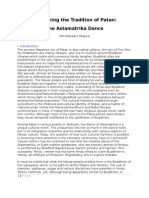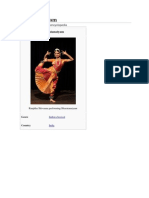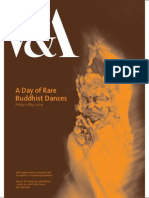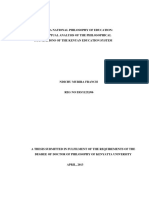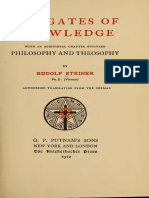0 ratings0% found this document useful (0 votes)
24 viewsThe Dance Divine
The Dance Divine
Uploaded by
SivasonThis document discusses the divine dance of Lord Shiva known as the Nataraja dance. It provides background on the dance, describing how it is celebrated annually in Saivite temples. It discusses the various locations and forms of Shiva's dance, and the spiritual and philosophical meanings behind the dance, with insights from Hindu scholars. The dance is seen as a representation of cosmic energy and the means to liberation from cycles of rebirth.
Copyright:
© All Rights Reserved
Available Formats
Download as PDF, TXT or read online from Scribd
The Dance Divine
The Dance Divine
Uploaded by
Sivason0 ratings0% found this document useful (0 votes)
24 views4 pagesThis document discusses the divine dance of Lord Shiva known as the Nataraja dance. It provides background on the dance, describing how it is celebrated annually in Saivite temples. It discusses the various locations and forms of Shiva's dance, and the spiritual and philosophical meanings behind the dance, with insights from Hindu scholars. The dance is seen as a representation of cosmic energy and the means to liberation from cycles of rebirth.
Original Description:
The Dance Divine
By P. R. KRISHNASWAMI IYER
சிவஞான பூஜா மலர் துன்மதி ஆண்டு - (1981)
பிரசுரம்: ஆங்கீரஸ S. வேங்கடேச சர்மா, மேலமாம்பலம், சென்னை – 600 033]
Copyright
© © All Rights Reserved
Available Formats
PDF, TXT or read online from Scribd
Share this document
Did you find this document useful?
Is this content inappropriate?
This document discusses the divine dance of Lord Shiva known as the Nataraja dance. It provides background on the dance, describing how it is celebrated annually in Saivite temples. It discusses the various locations and forms of Shiva's dance, and the spiritual and philosophical meanings behind the dance, with insights from Hindu scholars. The dance is seen as a representation of cosmic energy and the means to liberation from cycles of rebirth.
Copyright:
© All Rights Reserved
Available Formats
Download as PDF, TXT or read online from Scribd
Download as pdf or txt
0 ratings0% found this document useful (0 votes)
24 views4 pagesThe Dance Divine
The Dance Divine
Uploaded by
SivasonThis document discusses the divine dance of Lord Shiva known as the Nataraja dance. It provides background on the dance, describing how it is celebrated annually in Saivite temples. It discusses the various locations and forms of Shiva's dance, and the spiritual and philosophical meanings behind the dance, with insights from Hindu scholars. The dance is seen as a representation of cosmic energy and the means to liberation from cycles of rebirth.
Copyright:
© All Rights Reserved
Available Formats
Download as PDF, TXT or read online from Scribd
Download as pdf or txt
You are on page 1of 4
The Dance Divine
THE DANCE DIVINE
By P.
R. KRISHNASWAMI IYER
S.
- (1981)
, ,
600 033]
In Thillais Court a mystic Dance the Lord performs,
Whomso that sees it torment not Samsaric storms;
Thillais Court is Human Heart and Siva is the Soul,
Whom the Yogis do in Bliss behold with senses in control.
Lord Siva as Nritta Murti is called Nataraja the Sovereign Dancer. On the Arudra
day of the Margazhi month (Dhanurmas) every year a festival is celebrated in every Saivite
temple in propitiation of Sri Nataraja and the votaries of Siva will throng in thousands for
the sacred Arudra Darsana on the occasion.
The grandest celebration, attracting the largest number of devotees for the most soulstirring sight, is at Chidambaram. Nearer Madras, the festival is performed with equal grandeur
at Thiruvalangadu the Vataranya where, according to some, the Lord performed the
exquisite Dance originally, and vanquished Kali in Her Rival Dance by His Urdhva Tandava
pose (in which one leg rests on the ground and the other is lifted up straight parallel to the
resting leg).
The history, science, art and philosophy of the Divine Dance have appealed to the
greatest minds of the world and have been elaborately dealt with by both Indian and European
scholars and Nataraja is viewed as the symbol of the synthesized science, art and religion.
The occasion of Sivas Dance according to Koil Puranam was as follows: Once Siva went to confute a set of heretical sages of the Mimamsa school of thought
who were living in the forest of Tharaka. The sages made mad attempts to destroy Him by all
kinds of incantations and sacrificial fires and out of the latter emerged one by one, a tiger, a
serpent and a malignant dwarf. Siva danced all along and after killing the tiger wore its skin.
He made a garland of the snake and broke the dwarfs back by the tip of His foot.
The five well-known Sabhas or Theatres of Sivas Dance are Thiruvalangadu (Ratna
Sabha), Chidambaram (Kanaka-Sabha), Madura (Rajata-Sabha), Tinnevelly (Tamra-Sabha)
and Kutralam (Chitra-Sabha). Darsana (sight) of the Dance on the occasion of the annual
celebrations at any of the above centres on the Arudra day of the Margathi month is believed
to purge the beholders of all their sins, alleviate their sufferings and liberate from the sorrowful
cycle of birth and death.
The Dance Divine
The Nataraja Dance first revealed to the Rishis is known as Nadanta Dance and
besides this there are two other well-known dances of Siva the Deity Evening Dance and the
Dance on the Smasana or the cremation grounds. The daily dance at night-fall in Kailasa is
described in the Pradosha Stotra as follows: Siva dances to the accompaniment of Veena (lute), flute, Tala (cymbals) and Mridanga
(clay tomtom) respectively played on by Saraswathi. Indra, Brahma and Vishnu, Goddess
Lakshmi (the Spouse of Lord Vishnu) singing; while the Gandharvas, Yakshas, Vidyadharas
and hosts of all other beings dwelling in the three worlds and His Consort, Gauri the Mother
of the worlds seated on a throne of gold and precious stones witness the dance. The worship
of Siva at Pradosha time every day means the worship of all deities collecting around Siva at
the time and the worshipper becomes happy and prosperous.
The Smasana Dance is considered by some as primitive and pre-Aryan and is attributed
to Sivas Tamasic aspect at Bhairava or Virabhadra and constitutes the mid-night revels of Siva
and Kali on the cremation grounds. It is known as Tandava and its esoteric meaning according
to Sakti and Sakta literature is destruction of mans illusion and all other evils to which
humanity is heir.
THE RENAISSANCE OF DANCE
Dance is an ancient art of universal appreciation and patronage. India is famous for its
Bharata Natya. There are 108 kinds of dance according to the Natya Sastra. Dance is
considered to be the most perfect physical exercise. Set to musical hymns in praise of God, it
contributes at once to the physical suppleness and spiritual elevation of the dancer. The lofty
ideals and noble effects of dance had been gradually receding from the human mind. In India
the art was, till recently, practically relegated to professionals and dancing-girls dedicated to
temples. The awakening of the Dance consciousness followed by the abolition of the
Devadasi class has restored the art to its legitimate dignity and noble standard, with the result
that it is now looked upon as an enviable attainment of girls and a wholesome recreation for
body, mind and spirit.
THE PHILOSOPHY OF SIVAS DANCE
The mystic dance of Siva is the manifestation of primal rhythmic energy. It denotes the
kinetic aspect of the Cosmic Energy and the effulgent vitality of all creation. The divine Chit
sustains and vitalizes everything. In the Universal Spirit the entire universe is born, borne and
buried. The supreme consciousness permeates the entire universe and all creation and is the
one underlying Reality in all beings, known as Chit or Atma. The Chidakasa of the
Supreme Self is the Hridayakasa of the Atma and the ecstasy of the Dance of Siva at
Chidambaram (the centre of the universe) is experienced by every soul which is no other than
the Divine Chit dwelling in the hearts of beings but perceived by only those who have curbed
their passions and desires and controlled their senses and mind and turned them inwards upon
the Almighty within. Nataraja is the most perfect image of the energy above-described and
The Dance Divine
no artist of today, however great, could more exactly or more wisely create an image of that
energy, which science must postulate behind all phenomena.
THE GLORY OF HINDU ART AND CRAFT
In the case of the Nataraja images in bronze the very best South Indian genius and talent
of artistic smithery have been exercised and the various modes of dance have been skillfully
reproduced in them. The sculptural exhibition of the various poses of Dance in temple
Gopurams are also marvellous. The image of Siva in every one of these Forms has the demon
Apasmara-Purusha under the foot, the damaru or the drum in one of the right hands and fire
in one of the left hands. The image is the form of the Omkara Pranava Swarupa of God and
suggestive of (i) the union of Prakriti and Purusha, (ii) the five Divine Functions of creation,
preservation, dissolution, embodiment and gracious release (Srshti, Sthiti, Samhara, Tirobahva
and Anugraha) and (iii) the meaning of the Holy Panchakshara Mantra Namah Sivaya. His
creative drum, protective hand, destructive fire and liberating foot, plunge the beholding souls
into Beatitude and merge them into Himself. The Nataraja Dance is thus the emblem of Divine
Bliss, Divine Functions and Human Salvation. The ethics and aesthetics of the dance are
appealing to every sensitive soul and eminent scholars have dwelt on the meaning of the dance
of Siva and the Nataraja image, which reveal the glory of the Hindu art and philosophy.
Dr. Anandkumaraswami says: The essential significance of Sivas dance is three fold. First it is the image of His
Rhythmic Activity as the source of all movements within the cosmos, which is represented by
the Arch; secondly the purpose of the dance is to release the countless souls of men from the
snare of illusion; thirdly, the place of dance, Chidambaram, the centre of the universe, is within
the heart. The conception of Sivas Dance is a synthesis of science, religion and art. In the night
of Brahma nature is inert and cannot dance till Siva wills it. He rises from His own rapture and
dancing sends through inert matter pulsing waves of awakening sound and Lo! Matter also
dances appearing as a glory around about Him. Dancing, He sustains its manifold phenomena.
In the fullness of time still dancing. He destroys all forms and names by fire and gives new
rest.
In His Heart of Aryavaita the Earl of Ronaldshay says, The Nataraja is the plastic
presentation of a whole philosophy. In the whirl of dance one sees the Primal Energy which
gives life to all existence and so sustains the universe. Other aspects of the figure speak of
destruction of desire and the attaining of salvation there is a synthesis of Science, Art and
Religion therein.
ABOUT THE AUTHOR
LATE P. R. KRISHNASWAMY IYER
A true devotee of the Holy Scriptures Bhagavad Gita and knower of English, Tamil,
Telugu, Sanskrit and Grantham languages, he is the author of the Book Gleanings from the
Gita for which forewords have been given by Late Sarvapalli Radhakrishnan, Sir, C. P.
3
The Dance Divine
Ramaswami Iyer, Justice P. Venkataramana Rao, Prof. P. Sankaranarayanan and which was
published posthumously by his son Sri. P. K. Venkataraghavan. After the publication several
appreciations from great scholars like Dr. T. M. P. Mahadevan, K. Sankara Menon etc., poured
in and several reviews appeared in the newspapers and journals.
You might also like
- Basic Theory of BharathanatyamDocument9 pagesBasic Theory of BharathanatyamSubashini Jaganathan100% (10)
- Dowsing For SelfhealingDocument7 pagesDowsing For SelfhealingRalph Hall100% (7)
- Steiner - A Philosophy of FreedomDocument304 pagesSteiner - A Philosophy of FreedomEze Iván Duarte86% (7)
- Harinama Cintamani (English)Document95 pagesHarinama Cintamani (English)Dina-Anukampana DasNo ratings yet
- Healing MantrasDocument29 pagesHealing Mantrasasingh18in100% (15)
- Navaakshari and Tripurasundari HomasDocument7 pagesNavaakshari and Tripurasundari HomasBangaru BabuNo ratings yet
- Vajrayogini: Her Visualization, Rituals, and FormsFrom EverandVajrayogini: Her Visualization, Rituals, and FormsRating: 4.5 out of 5 stars4.5/5 (10)
- Basic Components of Worldview: Part 1: Core Worldview BeliefsDocument4 pagesBasic Components of Worldview: Part 1: Core Worldview Beliefsbrayan martinez100% (1)
- Doreen Virtue - Issue - Are You An Earth AngelDocument5 pagesDoreen Virtue - Issue - Are You An Earth AngelHon Ming Se THoe0% (1)
- KrystalAegis144 PDFDocument144 pagesKrystalAegis144 PDFTiahgee Dieson Daughtry100% (9)
- Wotan Left Hand PathDocument4 pagesWotan Left Hand PathAnonymous ovGxLE8TOr100% (4)
- Indian DanceDocument104 pagesIndian Dancebhisham67% (6)
- The Symbolic Dance of Shiva-NatarajaDocument3 pagesThe Symbolic Dance of Shiva-NatarajaSivason100% (1)
- The Sculpture of NatarajaDocument12 pagesThe Sculpture of NatarajaanupNo ratings yet
- Indi Templs - 17 (60-61)Document2 pagesIndi Templs - 17 (60-61)Guru VittalNo ratings yet
- The Dance of ShivaDocument7 pagesThe Dance of Shivaazai nabihNo ratings yet
- The Dance of ShivaDocument7 pagesThe Dance of ShivaSri KalyanNo ratings yet
- The Dance of ShivaDocument13 pagesThe Dance of Shivatito154aNo ratings yet
- Hindu ReflectionsDocument15 pagesHindu Reflectionsavoac22No ratings yet
- Depiction: (NƏT̪ Ə Ra DƷƏ) Tamil Malayalam Telugu Kannada Shiva BrahmaDocument4 pagesDepiction: (NƏT̪ Ə Ra DƷƏ) Tamil Malayalam Telugu Kannada Shiva BrahmanieotyagiNo ratings yet
- Indian Performing ArtsDocument21 pagesIndian Performing ArtsShashank Kumar SinghNo ratings yet
- The Dance of ShivaDocument11 pagesThe Dance of Shivachitratr_bala7846100% (1)
- Indian Dance: by Yogacharini Emy Blesio (Gayatri Devi)Document5 pagesIndian Dance: by Yogacharini Emy Blesio (Gayatri Devi)monika senthilNo ratings yet
- Arudhra DharsinamDocument3 pagesArudhra DharsinamAravindan SivanandanNo ratings yet
- Hinduism in Performing ArtsDocument16 pagesHinduism in Performing ArtsJinal RathodNo ratings yet
- Siddhanta Deepika Volume 13Document599 pagesSiddhanta Deepika Volume 13BosRaj100% (1)
- Siddhanta Deepika Volume 13Document599 pagesSiddhanta Deepika Volume 13Sivason100% (1)
- TVA BOK 0000648 SaivamDocument90 pagesTVA BOK 0000648 SaivamphantomkannanNo ratings yet
- Bharata NatyamDocument8 pagesBharata NatyamOscar RamirezNo ratings yet
- Bharatanatyam YogaDocument21 pagesBharatanatyam Yogalnln462lnNo ratings yet
- Symbols - Hindu Deities and Their VahanasDocument55 pagesSymbols - Hindu Deities and Their Vahanasyellammakuna2No ratings yet
- Cosmic Dance of NatrajaDocument2 pagesCosmic Dance of Natrajaabhipar649205No ratings yet
- NatarajaDocument5 pagesNatarajaBon Lester L. LampareroNo ratings yet
- Tandavam LasyamDocument33 pagesTandavam LasyamKiranmai BonalaNo ratings yet
- 08 Chapter 3Document103 pages08 Chapter 3Kuttiand BachaNo ratings yet
- UntitledDocument49 pagesUntitledMeghana DassNo ratings yet
- 08 AppendicesDocument33 pages08 AppendicesKirk WalkerNo ratings yet
- Indian Dance & MusicDocument85 pagesIndian Dance & MusicSunil Upadhyaya0% (1)
- Shiva As NatarajaDocument3 pagesShiva As NatarajaGray HoundyNo ratings yet
- Astamatrika Dance of Patan-RevDocument5 pagesAstamatrika Dance of Patan-RevMin Bahadur shakyaNo ratings yet
- Indian Traditional DanceDocument19 pagesIndian Traditional DanceOshi RathnayakeNo ratings yet
- 08 Chapter2 PDFDocument30 pages08 Chapter2 PDFmmabi sathishNo ratings yet
- 10 - Chapter 3 PDFDocument31 pages10 - Chapter 3 PDFPrithvi P. ShenoyNo ratings yet
- Shivanataraja 1Document7 pagesShivanataraja 1Gray HoundyNo ratings yet
- Shiva S Cosmic DanceDocument12 pagesShiva S Cosmic Dancesreescribd100% (1)
- 06 - Chapter 1 PDFDocument24 pages06 - Chapter 1 PDFYOGESWARI A/P SUBRAMANIAN STUDENTNo ratings yet
- Bollywood Largeprintv1Document210 pagesBollywood Largeprintv1Sachidananda KiniNo ratings yet
- Creation of MusicDocument67 pagesCreation of Musicmohanty_anantakumar6332No ratings yet
- Music & Sahajyoga - DR - Arun ApteDocument209 pagesMusic & Sahajyoga - DR - Arun Aptekatikineni100% (3)
- Ragaranta Malikache - PublicationDocument6 pagesRagaranta Malikache - PublicationAmrutha Music AcademyNo ratings yet
- The Yogic Dance of MahesvaraDocument23 pagesThe Yogic Dance of MahesvaraJoo Barbosa100% (1)
- THEORY PORTIONS For Dance SubjectDocument22 pagesTHEORY PORTIONS For Dance SubjectSkc100% (1)
- Nataraja-The Dancing SivaDocument8 pagesNataraja-The Dancing SivaSivasonNo ratings yet
- Bharata NatyamDocument9 pagesBharata NatyamkoyasrujanaNo ratings yet
- Bharatanatyamyoga PDFDocument21 pagesBharatanatyamyoga PDFDivya Shilpa RajeevNo ratings yet
- Bharata NatyamDocument11 pagesBharata NatyamKapil SinghNo ratings yet
- GS ProjectDocument25 pagesGS ProjectAditi AKNo ratings yet
- Masl 204Document54 pagesMasl 204sakshi chanekarNo ratings yet
- Shiva - The Ultimate Truth - The Art of Living GlobalDocument5 pagesShiva - The Ultimate Truth - The Art of Living GlobalAnonymous Hiv0oiGNo ratings yet
- Siva SutrasDocument62 pagesSiva Sutrasdoors-and-windowsNo ratings yet
- Va Buddhist DanceDocument9 pagesVa Buddhist Danceapi-58401172No ratings yet
- ŚrīMuttuswāmy Dīkshitar's Compositions On Goddess SaraswatīDocument5 pagesŚrīMuttuswāmy Dīkshitar's Compositions On Goddess SaraswatīIOSRjournalNo ratings yet
- New Microsoft Word DocumentDocument10 pagesNew Microsoft Word Documentdeepredrose143No ratings yet
- Ask- the Tree of Knowledge: “The Tree of Knowledge”From EverandAsk- the Tree of Knowledge: “The Tree of Knowledge”Rating: 5 out of 5 stars5/5 (1)
- Is This PeaceDocument80 pagesIs This PeaceSivasonNo ratings yet
- KalaprakasikaDocument481 pagesKalaprakasikaSivasonNo ratings yet
- KamakalavilasaDocument230 pagesKamakalavilasaSivasonNo ratings yet
- Outlines of VedantaDocument185 pagesOutlines of VedantaSivasonNo ratings yet
- Vedantasara of SadanandaDocument228 pagesVedantasara of SadanandaSivasonNo ratings yet
- Siva Agamas and Their Relationship To VedasDocument31 pagesSiva Agamas and Their Relationship To VedasSivason100% (1)
- Manikka Vacagar and His DateDocument94 pagesManikka Vacagar and His DateSivasonNo ratings yet
- Age of Sankara by Narayana Sastry PDFDocument156 pagesAge of Sankara by Narayana Sastry PDFGanesh Raaja NatarajanNo ratings yet
- Festivals of Tamil NaduDocument379 pagesFestivals of Tamil NaduSivasonNo ratings yet
- Life in Ancient India in The Age of The MantrasDocument156 pagesLife in Ancient India in The Age of The MantrasSivasonNo ratings yet
- Glimpses of KalidasaDocument62 pagesGlimpses of KalidasaSivasonNo ratings yet
- The Folk Songs of Southern IndiaDocument335 pagesThe Folk Songs of Southern IndiaSivasonNo ratings yet
- Agastya in The Tamil LandDocument98 pagesAgastya in The Tamil LandSivasonNo ratings yet
- Dravidian IndiaDocument270 pagesDravidian IndiaSivason100% (1)
- Tamil WisdomDocument140 pagesTamil WisdomSivasonNo ratings yet
- The Gospel of God RealisationDocument68 pagesThe Gospel of God RealisationSivasonNo ratings yet
- Pasupata SutramDocument235 pagesPasupata SutramSivasonNo ratings yet
- The Land of The VedaDocument567 pagesThe Land of The VedaSivasonNo ratings yet
- Indian Travel DiaryDocument250 pagesIndian Travel DiarySivasonNo ratings yet
- RamayanaDocument304 pagesRamayanaSivasonNo ratings yet
- KalhanaDocument100 pagesKalhanaSivasonNo ratings yet
- Pearls of WisdomDocument270 pagesPearls of WisdomSivasonNo ratings yet
- Hinduism Doctrine and Way of LifeDocument108 pagesHinduism Doctrine and Way of LifeSivasonNo ratings yet
- Aspirations From A Fresh WorldDocument204 pagesAspirations From A Fresh WorldSivasonNo ratings yet
- Immortal IndiaDocument283 pagesImmortal IndiaSivasonNo ratings yet
- Bhaja GovindamDocument78 pagesBhaja GovindamSivasonNo ratings yet
- Halayudhastava by HalayudhaDocument71 pagesHalayudhastava by HalayudhaSivasonNo ratings yet
- BILHANADocument102 pagesBILHANASivasonNo ratings yet
- The Samkhya Karika of Ishvara KrishnaDocument178 pagesThe Samkhya Karika of Ishvara KrishnaSivasonNo ratings yet
- PanchadashiDocument564 pagesPanchadashiSivasonNo ratings yet
- Ndichu Murira Francis PDFDocument216 pagesNdichu Murira Francis PDFVasia PapapetrouNo ratings yet
- Human Nature According To The Greek PhilosophersDocument48 pagesHuman Nature According To The Greek Philosophersbernice el mazeNo ratings yet
- Mysticism in 17th Century England - Elbert N. S. Thompson (1921)Document68 pagesMysticism in 17th Century England - Elbert N. S. Thompson (1921)Waterwind100% (1)
- Worksheet 1 USDocument3 pagesWorksheet 1 USKhan Hayudini SaliNo ratings yet
- Meeting of Alchemy and SoulDocument65 pagesMeeting of Alchemy and SouldeNo ratings yet
- Download full World of Art 7th Edition by Sayre Henry M. A Wei Zhi ebook all chaptersDocument24 pagesDownload full World of Art 7th Edition by Sayre Henry M. A Wei Zhi ebook all chaptersbazarlaackdx100% (1)
- The Milk Is WhiteDocument153 pagesThe Milk Is WhiteIan Gardner100% (8)
- Unit 1 General Characteristics of Indian PhilosophyDocument13 pagesUnit 1 General Characteristics of Indian PhilosophyShraddhaNo ratings yet
- Glancy, SlaveryDocument218 pagesGlancy, SlaveryDejan Mitrea100% (5)
- SF 3.2 - 7 Stages of Spiritual Growth - Part 2Document22 pagesSF 3.2 - 7 Stages of Spiritual Growth - Part 2eltropicalNo ratings yet
- Why The Novel MattersDocument11 pagesWhy The Novel MattersVesna DimcicNo ratings yet
- The Natural Law Theory of Thomas AquinasDocument5 pagesThe Natural Law Theory of Thomas AquinasAbby PajaronNo ratings yet
- The Indie Game Magazine April 2015 - Issue 48Document68 pagesThe Indie Game Magazine April 2015 - Issue 48Szakacs LorandNo ratings yet
- (Library of Philosophy and Religion) Paul Badham (Auth.) - Christian Beliefs About Life After Death-Palgrave Macmillan UK (1976)Document178 pages(Library of Philosophy and Religion) Paul Badham (Auth.) - Christian Beliefs About Life After Death-Palgrave Macmillan UK (1976)Ngoc NguyenNo ratings yet
- Sweet Talk-1-1Document6 pagesSweet Talk-1-1Såmmy Gëë100% (3)
- The Gates of Knowledge STEINER PDFDocument192 pagesThe Gates of Knowledge STEINER PDFandreacheiroNo ratings yet
- Educational Psychology-Concept and Meaning 041219 Unit4Document5 pagesEducational Psychology-Concept and Meaning 041219 Unit4ALI KAMRANNo ratings yet
- ST Catherine of Siena, The Life of - Raymundus de Vineis 1300sDocument472 pagesST Catherine of Siena, The Life of - Raymundus de Vineis 1300sWaterwind100% (3)
- Cornford 1903 - Plato and OrpheusDocument14 pagesCornford 1903 - Plato and OrpheusVincenzodamianiNo ratings yet
- Concept and Functions of EducationDocument19 pagesConcept and Functions of EducationPatrick batemenNo ratings yet
- Rhapsody of Realities Spanish PDF June 2016Document80 pagesRhapsody of Realities Spanish PDF June 2016pcarlosNo ratings yet
- ars 영문독해Document206 pagesars 영문독해김미나No ratings yet
